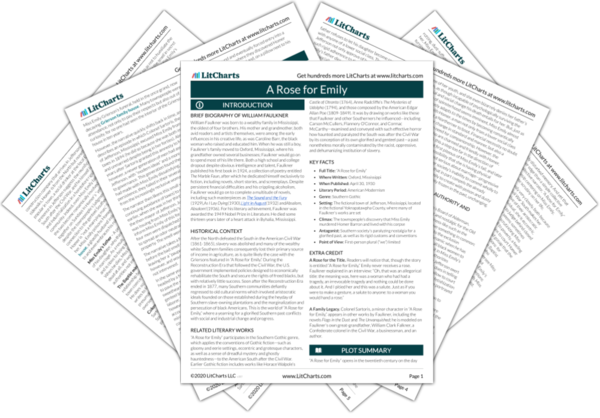Literary Theory and Criticism
Home › Literature › Analysis of William Faulkner’s A Rose for Emily

Analysis of William Faulkner’s A Rose for Emily
By NASRULLAH MAMBROL on June 12, 2021
Initially published in Forum on April 30, 1930, and collected in These Thirteen in 1931, “A Rose for Emily” remains one of William Faulkner’s most read, most anthologized, and most significant stories. From every imaginable perspective, critics have scrutinized the components of Faulkner’s literary technique: The story has been viewed as an allegory of southern history, a metaphorical depiction of NorthSouth relationships, feminist nightmare or feminist victory, a gothic horror story, a sociological portrayal of individualism squelched or individualism triumphant, a bleak fictional tale of determinism. Faulkner’s uses of structure, tone, point of view, and imagery play key roles in his depiction of Miss Emily Grierson. The fact that readers and critics still engage in interpretive debates over its meaning merely ensures that it will continue to be read.

Told from the perspective of Jefferson, in Yoknapatawpha County, in a narrative voice that consistently relates the details that “we”—the smug and gossipy townspeople of Jefferson—have observed, the story is intriguing on the level of plot and character alone: Miss Emily has just died, and we learn that she lived alone after her father died and Homer Baron, her Yankee lover, apparently abandoned her. Suspense continues to build when we learn that a mysterious odor emanated from her house at the time that Homer disappeared. Faulkner employs a number of clues to foreshadow both denouement and motivation, including the “tableau” of the imperious father with a horsewhip overshadowing his white-clad young daughter Emily; the portrait of her father that Emily displays at his death, despite his thwarting of her natural youthful desires; her defiant public appearances with the unsuitable Homer Baron; her sense of entitlement; and the arsenic she buys to rid her house of “rats.” Despite these and other devices, however, new generations of readers still react in horror when Emily’s secret is revealed: She not only murdered her lover but slept with his corpse in the attic bridal chamber she carefully prepared.
If Miss Emily is crazy (and most critics agree that she is), Faulkner implies that she has been made so by the constrictions of a father who refused to let her marry and by the conventions of a society that eagerly filled the void at his death. Numerous critics have suggested that behind the gothic horror of necrophilia and insanity in this classic story, Miss Emily Grierson is the oddly modern hero. Indeed, one critic asserts that we cannot understand any of Faulkner’s heroes if we do not understand Miss Emily, for she is the “prototype” of them all (Strindberg 877). As with other troubled Faulknerian protagonists, death literally frees Miss Emily—from patriarchy, from society’s conventions, from sexual repression, from the class structure she was taught to revere, from the useless existence of privileged women of her era, even from the burdens of southern history and slavery: With her death, her black servant, mysteriously complicit in his relation to Miss Emily, walks out of her house at the end of the story. In an interview at the University of Virginia, Faulkner suggested that Miss Emily deserved a rose for all the torment she had endured, and, whatever else they feel, most readers appear to agree with this sentiment.
BIBLIOGRAPHY Blotner, Joseph. Faulkner: A Biography. 2 Vols. New York: Random House, 1974. Rev. ed., New York: Random House, 1984. Carothers, James. Faulkner’s Short Stories. Ann Arbor: University of Michigan Press, 1985. Faulkner, William. “A Rose for Emily.” In Collected Short Stories. New York: Random House, 1940. Ferguson, James. Faulkner’s Short Fiction. Knoxville: University of Tennessee Press, 1991. Strindberg, Victor. “A Rose for Emily.” In Reader’s Guide to Short Fiction, edited by Noelle Watson, 577. Detroit: St. James Press, 1993.
Share this:
Categories: Literature , Short Story
Tags: American Literature , Analysis of William Faulkner’s A Rose for Emily , criticism of William Faulkner’s A Rose for Emily , essays of William Faulkner’s A Rose for Emily , guide of William Faulkner’s A Rose for Emily , Literary Criticism , notes of William Faulkner’s A Rose for Emily , plot of William Faulkner’s A Rose for Emily , summary of William Faulkner’s A Rose for Emily , themes of William Faulkner’s A Rose for Emily , William Faulkner , William Faulkner’s A Rose for Emily , William Faulkner’s A Rose for Emily appreciation , William Faulkner’s A Rose for Emily criticism , William Faulkner’s A Rose for Emily essays , William Faulkner’s A Rose for Emily guide , William Faulkner’s A Rose for Emily notes , William Faulkner’s A Rose for Emily plot , William Faulkner’s A Rose for Emily themes
Related Articles

You must be logged in to post a comment.

A Rose for Emily
William faulkner, ask litcharts ai: the answer to your questions.
Welcome to the LitCharts study guide on William Faulkner's A Rose for Emily . Created by the original team behind SparkNotes, LitCharts are the world's best literature guides.
A Rose for Emily: Introduction
A rose for emily: plot summary, a rose for emily: detailed summary & analysis, a rose for emily: themes, a rose for emily: quotes, a rose for emily: characters, a rose for emily: symbols, a rose for emily: theme wheel, brief biography of william faulkner.

Historical Context of A Rose for Emily
Other books related to a rose for emily.
- Full Title: “A Rose for Emily”
- Where Written: Oxford, Mississippi
- When Published: April 30, 1930
- Literary Period: American Modernism
- Genre: Southern Gothic
- Setting: The fictional town of Jefferson, Mississippi, located in the fictional Yoknapatawpha County, where many of Faulkner’s works are set
- Climax: The townspeople’s discovery that Miss Emily murdered Homer Barron and lived with his corpse
- Antagonist: Southern society’s paralyzing nostalgia for a glorified past, as well as its rigid customs and conventions
- Point of View: First-person plural (“we”) limited
Extra Credit for A Rose for Emily
A Rose for the Title. Readers will notice that, though the story is entitled “A Rose for Emily,” Emily never receives a rose. Faulkner explained in an interview: “Oh, that was an allegorical title: the meaning was, here was a woman who had had a tragedy, an irrevocable tragedy and nothing could be done about it. And I pitied her and this was a salute. Just as if you were to make a gesture, a salute to anyone: to a woman you would hand a rose.”
A Family Legacy. Colonel Sartoris, a minor character in “A Rose for Emily,” appears in other works by Faulkner, including the novels Flags in the Dust and The Unvanquished ; he is modeled on Faulkner’s own great-grandfather, William Clark Falkner, a Confederate colonel in the Civil War, a businessman, and an author.

William Faulkner: A Rose for Emily. Summary and analysis
Tabla de contenidos, summary of “a rose for emily”..
“A Rose for Emily,” a work by William Faulkner, a prominent author in American literature, initially published in 1930, is a story that delves into the themes of decline, isolation and resistance to change. The story, narrated by an unidentified observer, takes place in a Southern town and centers on the figure of Emily Grierson, a woman who becomes something of an enigma and object of curiosity to the community’s inhabitants.
The story begins with Emily’s death and the town’s inhabitants’ interest in visiting her home, a place closed to the outside world for many years. A series of flashbacks reveals crucial details of Emily’s life and her complex relationship with the town.
Emily, described as a relic of the past, resides in a once stately home, now dilapidated, symbolizing the decay of herself and traditional Southern values. Her father, an authoritative and controlling figure in life, had driven away all of Emily’s suitors, so she was left unmarried after his death. Emily’s refusal to acknowledge her father’s death for three days after his passing is the first indication of her disconnect with reality.
The arrival of Homer Barron, a laborer from the North, introduces a new chapter in Emily’s life. Despite the town’s rumors and skepticism, Emily and Homer seem to develop a relationship. However, Homer mysteriously disappears, and Emily secludes herself in her home, reaffirming her image as a lonely and mysterious figure.
After Emily’s death, the inhabitants discover that Homer’s corpse is lying on a bed in a locked room, along with a lock of gray hair presumed to be Emily’s. This revelation suggests a macabre and haunting connection between Emily and her once furtive lover.
The story explores resistance to change, the impact of rigid social structures and extreme loneliness. The fragmented, non-linear narrative, typical of Faulkner’s style, creates a sense of mystery and depth, allowing the reader to piece together Emily’s story and its meaning gradually. The story also examines the decline of the Old South and certain characters’ inability to adapt to social and temporal changes.

William Faulkner : A Rose for Emily
Cuento completo
Characters and their development throughout the narrative.
In “A Rose for Emily,” Faulkner presents a small but significant set of characters whose development is closely intertwined with the work’s central themes. The narrative is built around Emily Grierson but also includes secondary figures who contribute to the evolution of the plot and deepen the themes Faulkner develops in his story.
Emily Grierson: Emily is the central character of the story. Throughout the narrative, she is shown to transition from being a young girl in a prominent family to becoming a mysterious recluse. After the death of her father, a domineering and controlling being who rejected all her suitors, Emily finds herself alone and isolated. This isolation worsens over time, driving her into a state of denial and delusion, especially evident in her refusal to accept her father’s death and later in her relationship with Homer Barron. Emily is a complex character who represents resistance to change, the influence of the past and oppressive social norms.
Homer Barron: A Northern laborer, represents change and modernity that challenges Southern traditions. His relationship with Emily is viewed with suspicion and disapproval by the townspeople. The relationship never culminates in marriage, and mysteriously, Homer disappears. At the end of the story, it is revealed that this disappearance was caused by Emily, who poisoned him and then kept his body in a room in the old house. The figure of Homer and his ultimate fate are crucial to understanding the depth of Emily’s isolation and disturbance.
Emily’s father: Although dead before most of the events recounted in the story, the influence of Emily’s father is a constant presence. His control over Emily and his rejection of her suitors leave a profound mark on her psyche, contributing to her isolation and eventual imbalance. The father figure symbolizes the social restrictions and gender expectations of the time.
The community: Although not a “character” in the traditional sense, the community plays a vital role in the story. It serves as a Greek chorus, observing and commenting on Emily’s life. The town’s attitude toward Emily reflects the social norms and prejudices of the time. Their curiosity and gossip contribute to the narrative’s tone of mystery and judgment.
The development of these characters takes place through a series of flashbacks and anecdotes, which gradually reveal the complexity of their lives and relationships. Faulkner uses these characters to explore the various themes he develops in the story, creating a narrative fabric in which each character contributes to the plot and the more significant meaning of the story.

The setting of “A Rose for Emily”.
The play is set in a small town in the southern United States, in a time spanning from the late nineteenth century to the early twentieth century. This context is crucial, reflecting the South’s social and cultural tensions in transition after the Civil War.
Emily Grierson’s house: Emily’s house is a character and critical symbol in the story. Once stately and respected, it becomes a decrepit and decaying structure surrounded by garages and cotton tents. This physical transformation of the house reflects Emily’s physical and emotional deterioration and the decline of the Old South and its values. The house, with its locked rooms and dusty, stagnant atmosphere, is also a crucial setting for the story’s climax and final revelation.
The Southern Town: The town reflects the post-Civil War South, grappling with social and economic changes. The narrative highlights the transitioning from a society based on old honor codes and social hierarchies to a more modern, less stratified one. This change is illustrated in how the town’s characters interact with Emily and her family and how these changes affect their perception of them.
The era: The story spans several decades, allowing Faulkner to explore the impact of time on people and societies. The transition from the 19th century to the 20th century brought significant changes to the South, including attitudes toward class, gender, and the legacy of the Civil War. Emily’s resistance to these changes, symbolized by her house and lifestyle, reflects the tension between the past and the present.
Writing techniques employed by Faulkner in “A Rose for Emily.”
Non-linear and fragmented narrator: Faulkner opts for a non-linear narrative structure, moving back and forth in time. This technique creates a sense of mystery and allows the story to unfold gradually, revealing critical details at strategic moments. The fragmented narrative reflects the theme of decay and chaos, both in Emily’s life and Southern society.
Collective Narrator: The story is narrated by an unnamed narrator who represents the collective perspective of the townspeople. This approach creates distance between Emily and the reader while at the same time providing a panoramic view of how the community views and judges Emily and her family. This technique reinforces the themes of gossip, isolation, and social judgment.
Language: Faulkner is known for his rich and poetic use of language. In “A Rose for Emily,” he employs descriptive language to create a dense and evocative atmosphere. For example, the detailed descriptions of Emily’s house are vital to establishing the somber tone and decay that permeate the story.
Symbolism: The story is loaded with symbolism. Emily’s house, for example, symbolizes the decline of the Old South. At the same time, the rose of the title has been interpreted in various ways, including as a symbol of love and compassion for Emily. These symbols enrich the narrative, providing additional layers of meaning.
Themes and Motifs: Faulkner weaves several themes and motifs throughout the story, including death, the passage of time, and resistance to change. The use of these themes contributes to the depth and complexity of the story, allowing for multiple interpretations.
Character Psychology: Throughout his narrative, Faulkner deeply explores the psychology of his characters, especially Emily. This detailed approach offers intimate insight into their motivations, fears, and desires, which adds significant richness to the narrative.
In “A Rose for Emily,” Faulkner’s narrative style is complex and meticulously crafted. His non-linear approach, coupled with a collective narrator, richly descriptive language, use of symbolism, and in-depth exploration of themes and character psychology, creates a work that not only tells the story of a woman and a people but also offers a meditation on broader themes such as time, change, and memory.
Narrative point of view
Collective Narrator: The use of “we” in the narrative suggests that the narrator is a cooperative witness, representing the opinions, perceptions, and prejudices of the village community. This collective point of view is essential to understanding the relationship between Emily and the surrounding society. The narrator is not an individual but a composite voice reflecting the mindset and attitudes of the community.
Limited perspective: Despite witnessing the events in Emily’s life, the narrators have limited knowledge of her inner thoughts, feelings, and motivations. This limitation reinforces the mystery surrounding Emily and her story, as the reader only receives the information filtered through the perspective of the community’s inhabitants.
Implications of judgment and prejudice: By telling the story from the townspeople’s point of view, Faulkner allows the prejudices and judgments of the community to become part of the narrative. How the townspeople talk about Emily and her family reveals their social norms, expectations, and attitudes toward change and decay.
Distancing from the main character: Through this point of view, Emily is presented as an object of fascination and speculation, but she is always kept at an emotional distance from the reader. This distancing intensifies the aura of isolation and mystery surrounding her character.
Reliability of the narrator: The collective narrator in “A Rose for Emily” is unreliable. His account is tinged by gossip and community perceptions, which can lead to biased interpretations of events. This aspect adds a layer of complexity to the story, as the reader must discern reality from the narrator’s perceptions and biases.

Main themes addressed in the story
Isolation and loneliness: Emily Grierson is a profoundly isolated character, both physically and emotionally. This isolation is exacerbated by the death of her father and her inability to form meaningful relationships with others. Emily’s loneliness reflects her internal struggle and disconnection from the outside world.
Resistance to change: Resistance to change is a central theme in the story. Emily symbolizes it, clinging to traditions and ways of life. Her refusal to accept the death of her father and her relationship with Homer Barron are examples of her refusal to accept reality and adapt to change.
Decay: The story explores decay in the physical sense, with Emily’s house, and in the social and moral sense. The decay of Emily’s house parallels her own physical and mental deterioration and the decline of the traditions and values of the Old South.
Death: Death is a constant presence in the story, from the death of Emily’s father to her death and the revelation of Homer Barron’s corpse. Death is used to explore themes of loss, fear of loneliness, and the psychological impact of mortality.
Social Classes and Gender: The story addresses class differences and gender expectations in the South during the post-Civil War period. Emily, belonging to a family of high social standing, faces specific expectations due to her gender and class. Her relationship with Homer Barron, who represents a different social class and culture, challenges these norms.
Madness and obsession: Emily’s story also explores madness and obsession. Her behavior towards her dead father and Homer Barron suggests a disturbed mind, unable to accept reality and obsessed with maintaining control over her loved ones, even in death.
Tradition vs. modernity: The story reflects the conflict between the traditions of the Old South and the arrival of modernity. This theme is seen in Emily’s resistance to the new generations and how the community perceives her home and behavior.
Historical and cultural context
Published in 1930, the story is set in a small town in the southern United States and spans the late nineteenth century to the early twentieth century. This context reflects several significant social and cultural dynamics:
Post-American Civil War: The story is set in the South after the American Civil War. This era was one of significant social and economic change. The abolition of slavery and the defeat of the South led to a change in traditional social structures. This period was also marked by a struggle for reconstruction and the redefinition of Southern identity.
Reconstruction and resentment: The Reconstruction period saw attempts to integrate the defeated Southern states into the Union and to establish civil rights for formerly enslaved people. However, there was also strong resentment among many Southerners over these transformations, leading to racial and social tensions.
Decline of the Old South: Faulkner presents the Old South through Emily’s house and lifestyle. The physical decay of the house symbolizes the decay of a way of life and a set of values. The story captures the loss and nostalgia for an era that is disappearing.
Change vs. tradition: The South is transitioning, struggling between maintaining traditions and adapting to new changes. This is reflected in Emily’s resistance to accepting change in her life and her community.
Gender roles and social class: During this period, gender expectations and roles were firmly entrenched. As a woman from a high-status family, Emily faces specific pressures. Her isolation and defiant behavior can also be seen as a reaction to these restrictions.
Southern culture: Faulkner, a native of the American South, infuses the story with an intimate understanding of Southern culture. The importance of family reputation, honor, and community perceptions are central elements in the tale.

Conclusions or lessons to be drawn from the story.
Rather than offering direct conclusions or lessons, “A Rose for Emily” invites reflection on several critical aspects of human nature and society.
Impact of social isolation: The story illustrates how extreme isolation and lack of social interaction can lead to disorientation and madness. Emily Grierson, isolated first by her father and then by her own choices, shows how a lack of social connection can lead to destructive behavior and a distorted perception of reality.
Resistance to change and its consequences: The story reflects the struggle between change and tradition. Emily becomes a symbol of resistance to change, which ultimately leads to her ruin. This highlights that clinging to the past can impede personal growth and adaptation to new realities.
Effects of oppression and control: The oppressive influence of Emily’s father and the social expectations of the time illustrate how oppression and control can warp a person’s psyche. This suggests a critique of restrictive social structures and the imposition of rules that limit individual freedom.
Decay and death as universals: The story addresses the inevitability of decay and death in physical and symbolic terms. Emily’s story and the decay of her house are metaphors for mortality and the inevitable passage of time, universal themes in the human experience.
Reflection on social norms: The play also critiques social norms and how the community judges and labels individuals. The story questions the role of hearsay and community perceptions in shaping a person’s identity and reputation.
The importance of understanding and empathy: Although Emily is a tragic figure, the story invites readers to understand and empathize with her situation. This suggests a lesson about the importance of seeking to understand the struggles and contexts of others before judging them.
In conclusion, “A Rose for Emily” does not offer direct or explicit moral lessons; instead, it provides fertile ground for meditation on complex issues such as isolation, change, oppression, and the nature of society. Faulkner uses Emily’s story to explore these themes in a way that invites readers to reflect deeply on their meaning and relevance in the larger world.
Nuevo en Lecturia

H. G. Wells: The Stolen Bacillus

Mary Shelley: The Trial of Love

Ray Bradbury: The Handler

Agatha Christie: The Sign in the Sky
Kate chopin: the storm, ray bradbury: the veldt. summary and analysis.
Character Analysis of A Rose for Emily by William Faulkner Essay
- To find inspiration for your paper and overcome writer’s block
- As a source of information (ensure proper referencing)
- As a template for you assignment
The society plays a big role in ensuring all human beings have access to basic needs regardless of their social and economic status. The author of A Rose for Emily managed to portray this through the Townspeople who dedicated their resources to ensure Emily has access to a hygienic environment.
Love is evident in their commitment to exempt her from paying taxes and other levies due to the fact that she is poor and can not afford money for such payments. This essay discusses the character of the Townspeople with regard to the development of the themes and plot of the story.
From the outset it should be noted that the Townspeople have big hearts that allow them to help each other in times of disasters. The first scene of the story is about Emily’s funeral that is described as filled to capacity. This shows their commitment to helping their members in times of tragedies. It should be noted that human beings are social animals and can not live in isolation.
This forces the Townspeople to leave their daily activities and attend Emily’s funeral (Wheeler 34). Even though most people living in urban areas are usually busy and can not leave work to attend social functions, the people in the story dedicated this day to show their respect to one of their members.
In addition, it is not usual for a common beggar’s funeral to be filled to capacity but this was an exception as crowds filled her compound during her burial ceremony. This shows solidarity and unity among the Townspeople. However, these people have weird perceptions and motives that motivate them to attend Emily’s burial (Sharma 33).
We are told that men in particular adored her and viewed her as a symbol of a fallen hero. They admired her beauty before the death of her father and it is probable that most of them would have asked for her hand in marriage. In addition, women attended her funeral due to their curiosity that drove them to want to know what happened to her all these time she had resorted to live a solitary life.
When Emily’s father died and left her with no penny except for the old house the community decided to exempt her from paying taxes (Schmoop 78). In addition, they visited her regularly to help repair her house and do some cleaning on her compound. This is a brave act of concern and love for one another.
However, their philanthropy ends with the new generation of the Townspeople who demand that she pays taxes just like any other person. This indicates the effects of modernization that threatens to tear the love and sacrifices that human beings have towards their neighbors. It is evident that the local administration represents the modern generations that are clouded by material things and do not value human life (Faulkner 41).
The new mayor orders his men to go and demand that Emily pays taxes like other people. These effects are felt further when Homer Barron befriended Emily and they had predicted that the two were going to get married.
Even though some people are happy that Emily will have a companion many prophesize doom over that relationship. They think Homer is gay due to his drinking habit with young men and that he is from a rich family and can not marry a girl from a poor family.
This story captures all the intricate details of modern life that threatens the existence of love and compassion among members in any given society. It depicts how modernization controls important aspects of human life like love and concern for each other. It is one of the best approaches as to how tradition is being eroded by modern lifestyles that ignore the morals and relationships of human beings.
Works Cited
Faulkner, William . A Rose for Emily (A Tale Blazer) . Logan: Perfection Learning, 1990. Print.
Schmoop. A Rose for Emily: Schmoop Study Guide . New York: Schmoop University Press, 2009. Print.
Sharma, Raja. A Rose for Emily: Complete Summary and Analysis . Raleigh: Lulu Publishers, 2010. Print.
Wheeler, David. “A Rose for Emily” William Faulkner: A Critical Analysis . New York: Dogs Tail Books, 2011. Print.
- Binary Opposition in Faulkner’s "A Rose for Emily"
- William Faulkner and His Rose for Emily
- “A Rose for Emily” by Faulkner
- The Story of an Hour by Kate Chopin
- Vocabulary Learning in an Automated Graded Reading Program and Self-Identity Changes and English Learning among Chinese
- Nathaniel Hawthorne: Pearl and "The Scarlet Letter"
- Impact of Motivation on Second Language Acquisition
- A Week Later' by Sharon Olds
- Chicago (A-D)
- Chicago (N-B)
IvyPanda. (2019, May 16). Character Analysis of A Rose for Emily by William Faulkner. https://ivypanda.com/essays/character-analysis-of-a-rose-for-emily-by-william-faulkner-essay/
"Character Analysis of A Rose for Emily by William Faulkner." IvyPanda , 16 May 2019, ivypanda.com/essays/character-analysis-of-a-rose-for-emily-by-william-faulkner-essay/.
IvyPanda . (2019) 'Character Analysis of A Rose for Emily by William Faulkner'. 16 May.
IvyPanda . 2019. "Character Analysis of A Rose for Emily by William Faulkner." May 16, 2019. https://ivypanda.com/essays/character-analysis-of-a-rose-for-emily-by-william-faulkner-essay/.
1. IvyPanda . "Character Analysis of A Rose for Emily by William Faulkner." May 16, 2019. https://ivypanda.com/essays/character-analysis-of-a-rose-for-emily-by-william-faulkner-essay/.
Bibliography
IvyPanda . "Character Analysis of A Rose for Emily by William Faulkner." May 16, 2019. https://ivypanda.com/essays/character-analysis-of-a-rose-for-emily-by-william-faulkner-essay/.
A Rose for Emily

33 pages • 1 hour read
A modern alternative to SparkNotes and CliffsNotes, SuperSummary offers high-quality Study Guides with detailed chapter summaries and analysis of major themes, characters, and more.
Story Analysis
Character Analysis
Symbols & Motifs
Literary Devices
Important Quotes
Essay Topics
Discussion Questions
Emily Grierson
Emily Grierson is the complicated, dynamic figure at the center of this story. The narrative begins with her funeral but describes her at all points of life. Emily is portrayed as a reclusive and eccentric figure, a local curiosity maintained by the town. However, as the story progresses, it becomes clear that her isolation is the result of her father’s overbearing nature and her own personal traumas. Her character arc is one of decline, as she becomes increasingly isolated and detached from reality as the story unfolds. As a young woman, Emily is “a slender figure in white” (51) dominated by her overbearing father and powerful family history. The lack of details about Emily in this period reflects her enforced isolation. The narrative voice of Jefferson sees her only as a slim, virginal accessory to her father’s power.

Don't Miss Out!
Access Study Guide Now
Related Titles
By William Faulkner
Absalom, Absalom

As I Lay Dying

Barn Burning

Dry September

Go Down, Moses

Intruder In The Dust

Light in August

Spotted Horses
That Evening Sun

The Reivers

The Sound and the Fury

The Unvanquished
Featured Collections
Nobel Laureates in Literature
View Collection
Southern Gothic
Home / Essay Samples / Literature / A Rose For Emily / A Rose For Emily: Character Analysis
A Rose For Emily: Character Analysis
- Category: Literature
- Topic: A Rose For Emily
Pages: 1 (660 words)
- Downloads: -->
Isolation and Loneliness
Resistance to change, symbolism of the rose.
--> ⚠️ Remember: This essay was written and uploaded by an--> click here.
Found a great essay sample but want a unique one?
are ready to help you with your essay
You won’t be charged yet!
The Lottery Essays
A Rose For Emily Essays
The Scarlet Letter Essays
Brave New World Essays
Catcher in The Rye Essays
Related Essays
We are glad that you like it, but you cannot copy from our website. Just insert your email and this sample will be sent to you.
By clicking “Send”, you agree to our Terms of service and Privacy statement . We will occasionally send you account related emails.
Your essay sample has been sent.
In fact, there is a way to get an original essay! Turn to our writers and order a plagiarism-free paper.
samplius.com uses cookies to offer you the best service possible.By continuing we’ll assume you board with our cookie policy .--> -->